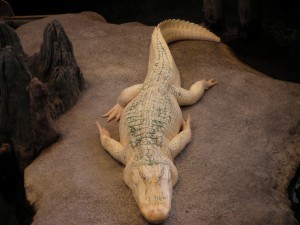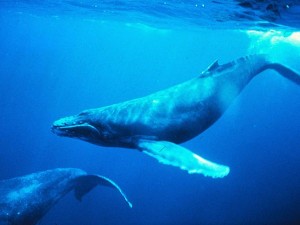Moving around is usually at the top of any evolutionary “got to have” checklist. From Jellyfish to fish of all stripes, to land animals to us, improvements in locomotion confer a survival advantage. It is challenging to find an adaptation with even a fraction of the impact on locomotion that the development of the vertebral column has had. Indeed, most of the animals that can be seen without the aid of a microscope are descendants of the species that worked out the design of the spine and are collected under the designation vertebrates. Insects and creatures with hard shells(but not turtles) continue to develop along the path their ancestors had chosen, forgoing the spine.
The original role of the spine was to flex, to translate muscle action into motive force. When we eat fish, what is on our plate are their muscles of locomotion. As a fish pushes itself through water large muscles along its sides, which are attached to the spine and ribs (the fish bones we have to watch for) contract against the spine first to one side and then the other, creating forward motion. This action bends the spine and changes the alignment of the vertebrae. Handling these uneven compressive forces was the of development that eventually produced the basic layout of our spinal bones, our intervertebral discs, tendons and muscles, and peripheral and central nervous systems. Maximizing the potential of this side to side propulsion occupied many thousands of generations of sea creatures.
At some point, the margin for improvement in the design of lateral locomotion through water diminished to the point that to gain competitive advantage animals were forced onto land. Their lateral fins morphed into short legs with which they could push forward against solid earth. Breathing without water, staying hydrated and these stubby legs were the essential design changes needed to get going on land. Some reptiles today still maintain this body plan, moving by flexing their bodies from side to side. The power and strength of reptiles are in the sides of their trunks, and to move ahead they engage their whole bodies. This type of locomotion can be extremely powerful, but is inefficient for movement over long distances. Especially when combined with ambient temperature (cold-blooded) metabolism, horizontal undulation is only useful for short bursts of activity.
The action of bi-directional flexion within the length of the spine is called undulation. This side to side movement of the spine pumps the fluid enclosing the spine and brain. Undulation is as important for cleansing the brain as the movement of the body is for lymph flow. (see lymph post)Given that the brain and spine co-evolved with vertebrate morphology, any additional pumping mechanism for flushing the central nervous system wouldn’t have conferred an advantage, and the brain has mostly relied on undulation of the spine to remove metabolic waste and toxins for over 400 million years.
If the torso is rigidly maintained on the midline and the powerful muscles of locomotion are moved to the limbs, movement becomes much more efficient as energy is not wasted moving the mass of the body side to side. The muscles connecting the limbs to the torso can use this rigid midline to push and pull the body. We see this development in most later land animal body designs. Once lateral rigidity in the torso was established it became possible to add even more thrust to movement. Developing vertical flexion/extension of the spine which engages the muscles on the front and back of the body can push in back extension with the rear limbs and pull with abdominal flexion using the front limbs. These animals exhibit vertical undulation, which when combined with warm-blooded metabolism creates a fast, efficient body plan that, like its ancestral cousin, horizontal undulation, flushes the brain. Warm-blooded metabolism requires more oxygen and more powerful lungs which need a rigid rib cage and strong diaphragm muscles.
Some of these mammals returned to the oceans. It is very rare in evolution for body plans to reverse to a previous design, and these mammals evolved propulsion based on flexion/extension of the spine. In other words, when moving straight ahead, their rear fins are parallel with the water surface. This morphology makes it easier for them to bend upward and “breach” the surface, which is why we see them and not fish doing this. It is also easier for them to stand vertically in the water.
It is important to remember that each layer of development is an adaptation of prior design and remnants of those designs can still be seen in our structure. Embryogenesis is the process of layering more complex adaptations on top of foundational neuro-structural designs. Some animals, in branching out into a variety of settings came to rely on the spine as a vertical column, as a weight-bearing structure. A weight-bearing joint is a much more complex structure, and there are trade-offs between the simplicity of design, weight-bearing capacity, and flexibility. If the spine were to be designed from the ground up as a somewhat flexible, weight-bearing structure it would look very different than the adaptation from a prior design that it is. Given this constraint, the spine is a breathtaking piece of engineering which continues to instruct us in structural design (see tensegrity). One of the trade off’s in getting our heads on top of our bodies is that we no longer were able to pump spinal fluid in the way our four-legged forefathers did. Stabilizing a column is pretty much the opposite of undulation. Flushing metabolic wastes became more challenging. In our native habitat where we were constantly in motion, this was not much of a problem. When the weight of the head is properly balanced on top of the spine, in running or even walking the head is pushed up and then pulled down with each stride, putting the spine into traction as well as compression and pumping the spinal fluid. When running properly, one feels as if one is floating along as the mass of the skull seems to pull the body up as much as gravity is pulling the body down. Additionally, a properly functioning skull minutely expands and contracts, creating constantly changing pressure around the spine and brain, which assists this flow. (see craniosacral post). We also, of course, still have quite a lot of flexion/extension and a little lateral flexibility.
Exercises
1) UNDULATION EXERCISE
2) Crawling is another excellent exercise. It is an opportunity for the spine to move without compressive loads, allowing the discs to heal. Flexing and extending as well as side to side motion without compressive loads replaces the fluid bathing the inter-vertebral discs, healing and rejuvenating them, in addition to pumping spinal fluid and opening the nerve channels. Finding opportunities to crawl is challenging and is also hard on the knees. I know someone who enjoys crawling so much that she keeps kneepads on in the house so she can crawl from room to room. She is in her mid 70’s and will do a headstand at the drop of a hat.
CRAWLING
3) CLIMBING
4) Manual Therapy will identify and release lesions in spinal flexibility. In a vertically loaded (dynamic) structure such as our spines, a small lesion can translate into adaptations across the entire body. Manual Therapy is an excellent means of identifying and releasing these areas of holding. (more information on Manual Therapy)
5) Reflex Arc exercises evaluate the isolated motor response for a specific stimulus. These are the building blocks that combine into stress-free movements and behaviors. If the motor response to stimuli is adaptive or “confused”, it will inhibit the free movement of the spine. There are many reflexes associated with spinal motion include Perez, Gallant, Trunk Extension, leg cross flexion, and Moro. Reflex exercises for these reflexes also pump spinal fluid, especially Perez. Some basic exercises can be found in Masgutova’s Infant Postural and Dynamic Reflex manual. Help to identify inhibited patterns and developing a program for strengthening their responses can be found here:
META READING
Overview of discussions on the Spine:
SPINE
A post on the functional mechanism the Spine supports:
POSTURAL EXTENSION
A post on the dynamics of Stance:
STANCE
Overview of discussions on our Locomotive Core:
LOCOMOTIVE CORE
Overview of discussions on our core neurophysiology:
THE FOUR CORES


